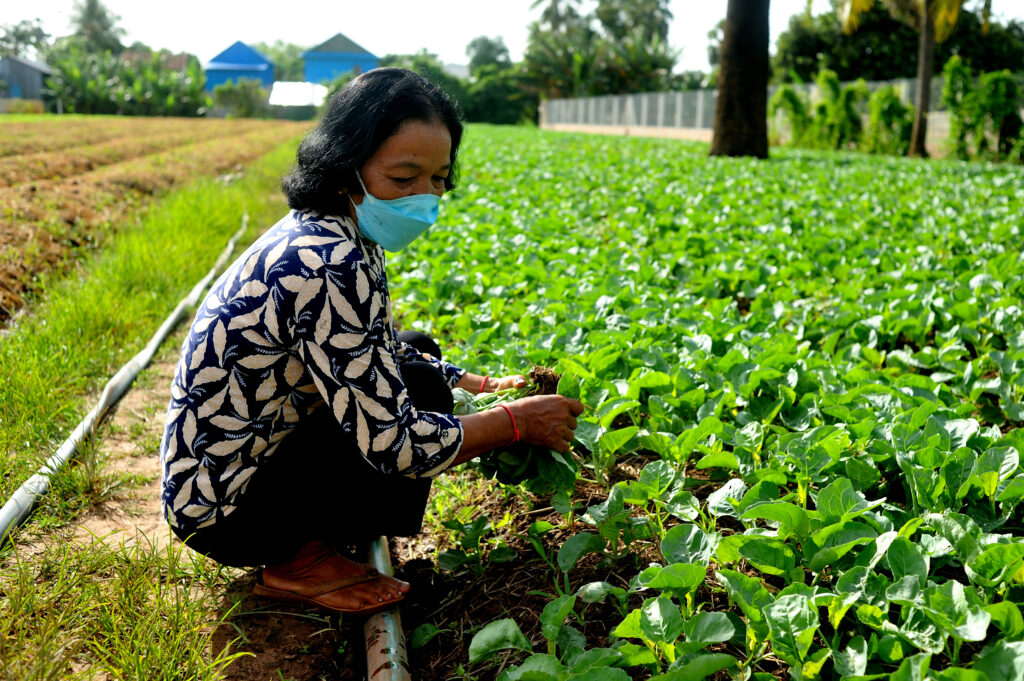When discussing food security, the food on our plate is just the tip of the iceberg. There is a need to look beyond what is on our dining room table and see the bigger picture.

In Cambodia, everyone works in order to have food on their table or khontel – a traditional Khmer sedge mat on which households commonly eat – and when people talk about food, often the first thing that comes to mind is what’s on their plates. But they are less likely to consider the origins of food, who grows it and the livelihoods of these farmers, all of which contribute to food security and play a role in the food supply chain.
As defined by the UN at the 1996 World Food Summit, food security is a stage where “all people, at all times, have physical, social, and economic access to sufficient, safe, and nutritious food that meets their food preferences and dietary needs for an active and healthy life.”
Food security is an issue that affects everyone in the country and awareness is the first step towards reaching this important goal, however, experts are concerned that very few people in Cambodia understand the concept.

Photo by: Sopheavuhtey Borin
“We need to find the right message and tool.”
“It [Food Security] is a complex idea, and even we struggle to make it clear,” said Iean Russell, Senior Policy Advisor at the Food and Agriculture Organization of the United Nations Cambodia (FAO). “We need to make it simple. But sometimes, it gets very complicated for people.”
Besides the lack of public awareness, according to Common Agricultural Policy (CAP) the main threat to food security are: world population growth, the increase demand for food, food price, the disappearance of the variety of agricultural plant species, the increase in the area of scarcity water, as well as, the limitation of the availability of land and the food losses and food waste.
Speaking specifically of young people, Russel said, “We need to find the right message and tool.”
Seeing the increasing importance of social media in people’s lives, particularly young Cambodians, an online collaborative media project called MHOPe has been created by Heinrich Boell Stiftung (HBS), a German Foundation that strives to promote democracy, civil society, human rights, international understanding and a healthy environment.
A play on the Khmer word for “food,” the MHOPe project aims to raise awareness on the origins of the food that we eat by highlighting the individual life stories of the workers at every step on the path from farm to table.
“I believe “Mhope and what we eat” is an introduction to the foundation of sustainable food understanding”, said MHOPe team member in charge illustrations.
“By learning the process, we can learn to give value to what we make, and the food we eat. We learn to appreciate the effort of each process.”
MHOPe plans to do so by using a traditional Cambodian dish (samlor korko) to describe the socio-economic aspects of nutrition, food security and the food cycle. It gives visibility to the women and men whose work is the foundation for our food and nutrition.
Samlor korko is one of the most popular and beloved traditional Khmer dishes, to both locals and foreigners. The soup consists of various vegetables, prahok (fish paste), kroeung (mixed herbs) and different meat according to the cook’s preference, however, fish is most common.
Photo by: MHOPe/Miguel Jeronimo
Visiting the MHOPe facebook page, audiences are exposed to content in a variety of mediums, including videos, photo-stories, articles, and illustrations. One of their on-going video series is “1001 Ways of Samlor Korko.” The series depicts the female celebrity Chef Nak, talking to women of different backgrounds about different ways of making somlor korko and the nutritional facts around this national soup. Talking to them illustrates the choices that women make to feed their families, which is often determined by affordability.
“In Cambodia, we have a lot of food. But, to me, if it’s not safe and nutritious, it’s not food. That’s why food security and nutrition have to come together.”
Having worked to strengthen food security in Cambodia for decades, Russell believes awareness is this first step. When talking about food security, he thinks we should focus less on the availability of food, but more on the affordability and accessibility of good quality, nutritious and safe food.
“In Cambodia, we have a lot of food. But, to me, if it’s not safe and nutritious, it’s not food,” he said. “That’s why food security and nutrition have to come together.”
Taking samlor korko as an example, Iean Russell believes that a lot of traditional Khmer dishes – which often include fish more than red meat – provide good nutrition. However, the problem lies with how people cook nowadays.
“We tend to add a large amount of sugar or MSG to the original recipe,” Russell said. “The way we cook is not as good and healthy as how it was in the past.”
Photo by: MHOPe/Miguel Jeronimo
Achieving food security and nutrition for all while encouraging a healthy balance between socio-economic and environmental sustainability are defined in Cambodia’s Roadmap for Food Systems for Sustainable Development 2030. There is the need to make the plans highlighted in the roadmap accessible to every Cambodian. MHOPe sees that need and intends to support the project’s accomplishments by increasing people’s awareness of the topic so that the overall goal can be achieved.
Understanding that making people aware of the issues surrounding the food system is a challenging task, MHOPe’s project team believes reaching out to everyday people is vital to the future of the country.
The team explained, “To reach this vision, there is a need for an increased awareness and civic engagement around current systems, unhealthy and unsustainable food and nutritional patterns in society.”










